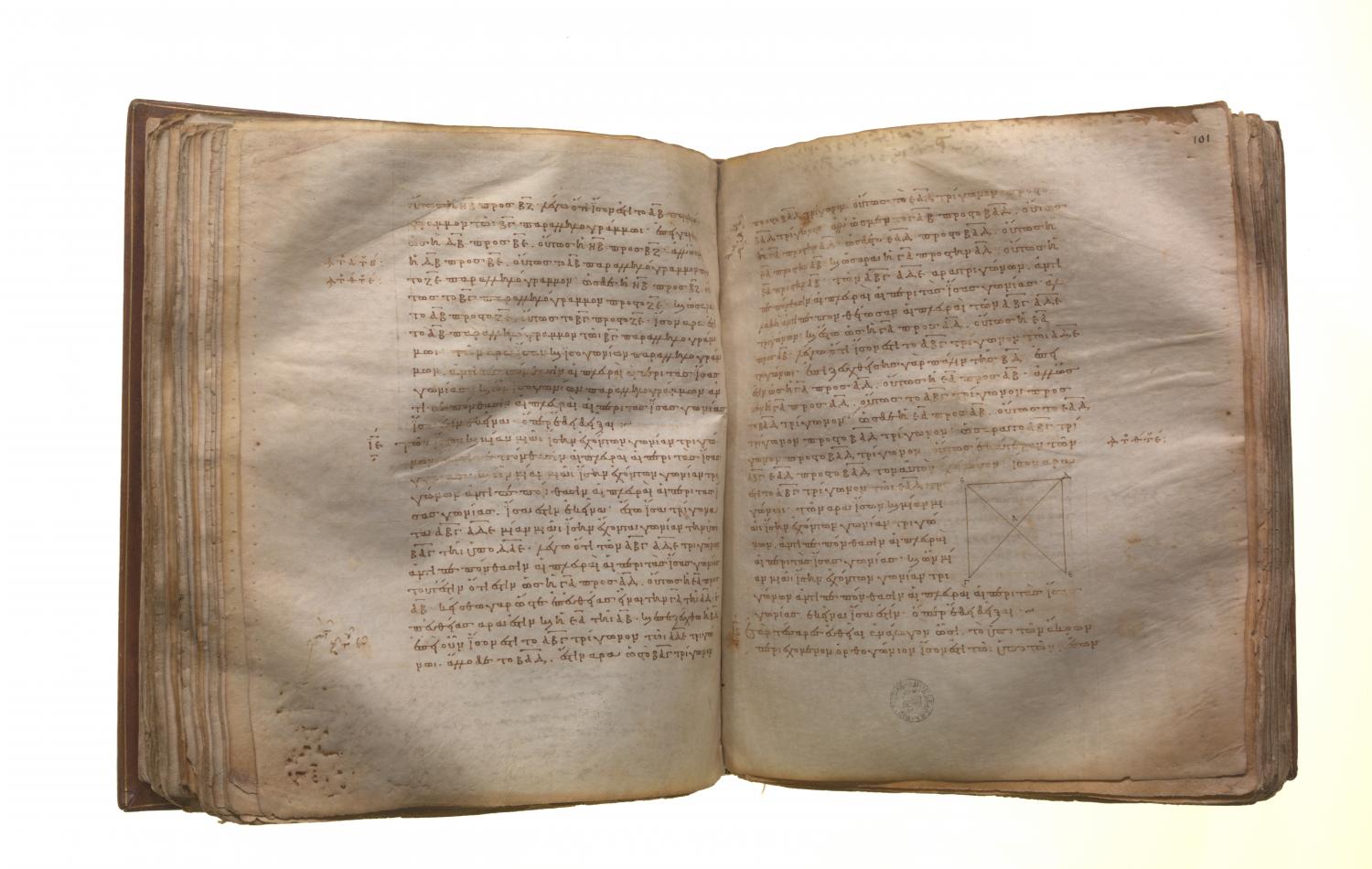Ἐὰν τέσσαρες εὐθεῖαι ἀνάλογον ὦσιν, τὸ ὑπὸ τῶν ἄκρων περιεχόμενον ὀρθογώνιον ἴσον ἐστὶ τῷ ὑπὸ τῶν μέσων περιεχομένῳ ὀρθογωνίῳ: κἂν τὸ ὑπὸ τῶν ἄκρων περιεχόμενον ὀρθογώνιον ἴσον ᾖ τῷ ὑπὸ τῶν μέσων περιεχομένῳ ὀρθογωνίῳ, αἱ τέσσαρες εὐθεῖαι ἀνάλογον ἔσονται. Ἔστωσαν τέσσαρες εὐθεῖαι ἀνάλογον αἱ ΑΒ, ΓΔ, Ε, Ζ, ὡς ἡ ΑΒ πρὸς τὴν ΓΔ, οὕτως ἡ Ε πρὸς τὴν Ζ: λέγω, ὅτι τὸ ὑπὸ τῶν ΑΒ, Ζ περιεχόμενον ὀρθογώνιον ἴσον ἐστὶ τῷ ὑπὸ τῶν ΓΔ, Ε περιεχομένῳ ὀρθογωνίῳ. Ἤχθωσαν [γὰρ] ἀπὸ τῶν Α, Γ σημείων ταῖς ΑΒ, ΓΔ εὐθείαις πρὸς ὀρθὰς αἱ ΑΗ, ΓΘ, καὶ κείσθω τῇ μὲν Ζ ἴση ἡ ΑΓ, τῇ δὲ Ε ἴση ἡ ΓΘ. καὶ συμπεπληρώσθω τὰ ΒΗ, ΔΘ παραλληλόγραμμα. Καὶ ἐπεί ἐστιν ὡς ἡ ΑΒ πρὸς τὴν ΓΔ, οὕτως ἡ Ε πρὸς τὴν Ζ, ἴση δὲ ἡ μὲν Ε τῇ ΓΘ, ἡ δὲ Ζ τῇ ΑΗ, ἔστιν ἄρα ὡς ἡ ΑΒ πρὸς τὴν ΓΔ, οὕτως ἡ ΓΘ πρὸς τὴν ΑΗ. τῶν ΒΗ, ΔΘ ἄρα παραλληλογράμμων ἀντιπεπόνθασιν αἱ πλευραὶ αἱ περὶ τὰς ἴσας γωνίας. ὧν δὲ ἰσογωνίων παραλληλογράμμων ἀντιπεπόνθασιν αἱ πλευραὶ αἱ περὶ τὰς ἴσας γωνίας, ἴσα ἐστὶν ἐκεῖνα: ἴσον ἄρα ἐστὶ τὸ ΒΗ παραλληλόγραμμον τῷ ΔΘ παραλληλογράμμῳ. καί ἐστι τὸ μὲν ΒΗ τὸ ὑπὸ τῶν ΑΒ, Ζ: ἴση γὰρ ἡ ΑΗ τῇ Ζ: τὸ δὲ ΔΘ τὸ ὑπὸ τῶν ΓΔ, Ε: ἴση γὰρ ἡ Ε τῇ ΓΘ: τὸ ἄρα ὑπὸ τῶν ΑΒ, Ζ περιεχόμενον ὀρθογώνιον ἴσον ἐστὶ τῷ ὑπὸ τῶν ΓΔ, Ε περιεχομένῳ ὀρθογωνίῳ. Ἀλλὰ δὴ τὸ ὑπὸ τῶν ΑΒ, Ζ περιεχόμενον ὀρθογώνιον ἴσον ἔστω τῷ ὑπὸ τῶν ΓΔ, Ε περιεχομένῳ ὀρθογωνίῳ: λέγω, ὅτι αἱ τέσσαρες εὐθεῖαι ἀνάλογον ἔσονται, ὡς ἡ ΑΒ πρὸς τὴν ΓΔ, οὕτως ἡ Ε πρὸς τὴν Ζ. Τῶν γὰρ αὐτῶν κατασκευασθέντων, ἐπεὶ τὸ ὑπὸ τῶν ΑΒ, Ζ ἴσον ἐστὶ τῷ ὑπὸ τῶν ΓΔ, Ε, καί ἐστι τὸ μὲν ὑπὸ τῶν ΑΒ, Ζ τὸ ΒΗ: ἴση γάρ ἐστιν ἡ ΑΗ τῇ Ζ: τὸ δὲ ὑπὸ τῶν ΓΔ, Ε τὸ ΔΘ: ἴση γὰρ ἡ ΓΘ τῇ Ε: τὸ ἄρα ΒΗ ἴσον ἐστὶ τῷ ΔΘ. καί ἐστιν ἰσογώνια. τῶν δὲ ἴσων καὶ ἰσογωνίων παραλληλογράμμων ἀντιπεπόνθασιν αἱ πλευραὶ αἱ περὶ τὰς ἴσας γωνίας. ἔστιν ἄρα ὡς ἡ ΑΒ πρὸς τὴν ΓΔ, οὕτως ἡ ΓΘ πρὸς τὴν ΑΗ. ἴση δὲ ἡ μὲν ΓΘ τῇ Ε, ἡ δὲ ΑΗ τῇ Ζ: ἔστιν ἄρα ὡς ἡ ΑΒ πρὸς τὴν ΓΔ, οὕτως ἡ Ε πρὸς τὴν Ζ. Ἐὰν ἄρα τέσσαρες εὐθεῖαι ἀνάλογον ὦσιν, τὸ ὑπὸ τῶν ἄκρων περιεχόμενον ὀρθογώνιον ἴσον ἐστὶ τῷ ὑπὸ τῶν μέσων περιεχομένῳ ὀρθογωνίῳ: κἂν τὸ ὑπὸ τῶν ἄκρων περιεχόμενον ὀρθογώνιον ἴσον ᾖ τῷ ὑπὸ τῶν μέσων περιεχομένῳ ὀρθογωνίῳ, αἱ τέσσαρες εὐθεῖαι ἀνάλογον ἔσονται: ὅπερ ἔδει δεῖξαι.
If four straight lines be proportional, the rectangle contained by the extremes is equal to the rectangle contained by the means; and, if the rectangle contained by the extremes be equal to the rectangle contained by the means, the four straight lines will be proportional. Let the four straight lines AB, CD, E, F be proportional, so that, as AB is to CD, so is E to F; I say that the rectangle contained by AB, F is equal to the rectangle contained by CD, E. Let AG, CH be drawn from the points A, C at right angles to the straight lines AB, CD, and let AG be made equal to F, and CH equal to E. Let the parallelograms BG, DH be completed. Then since, as AB is to CD, so is E to F, while E is equal to CH, and F to AG, therefore, as AB is to CD, so is CH to AG. Therefore in the parallelograms BG, DH the sides about the equal angles are reciprocally proportional. But those equiangular parallelograms in which the sides about the equal angles are reciprocally proportional are equal; [VI. 14] therefore the parallelogram BG is equal to the parallelogram DH. And BG is the rectangle AB, F, for AG is equal to F; and DH is the rectangle CD, E, for E is equal to CH; therefore the rectangle contained by AB, F is equal to the rectangle contained by CD, E. Next, let the rectangle contained by AB, F be equal to the rectangle contained by CD, E; I say that the four straight lines will be proportional, so that, as AB is to CD, so is E to F. For, with the same construction, since the rectangle AB, F is equal to the rectangle CD, E, and the rectangle AB, F is BG, for AG is equal to F, and the rectangle CD, E is DH, for CH is equal to E, therefore BG is equal to DH. And they are equiangular But in equal and equiangular parallelograms the sides about the equal angles are reciprocally proportional. [VI. 14] Therefore, as AB is to CD, so is CH to AG. But CH is equal to E, and AG to F; therefore, as AB is to CD, so is E to F.

